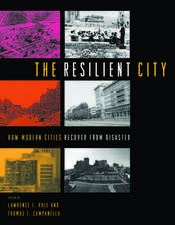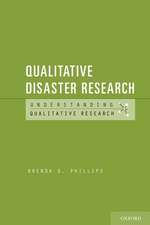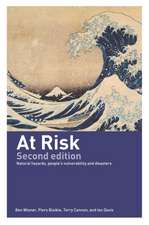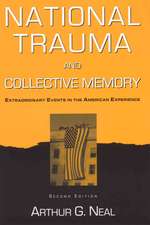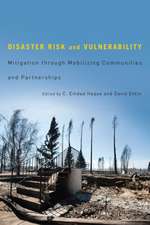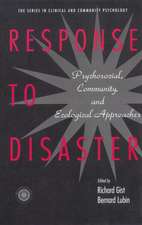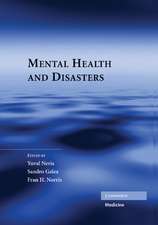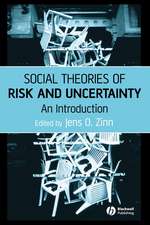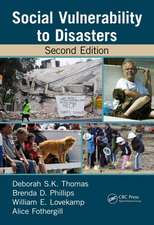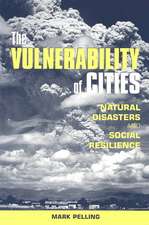Catalogue of Risks: Natural, Technical, Social and Health Risks
Autor Dirk Proskeen Limba Engleză Paperback – 19 oct 2010
| Toate formatele și edițiile | Preț | Express |
|---|---|---|
| Paperback (1) | 1009.85 lei 6-8 săpt. | |
| Springer Berlin, Heidelberg – 19 oct 2010 | 1009.85 lei 6-8 săpt. | |
| Hardback (1) | 662.16 lei 6-8 săpt. | |
| Springer Berlin, Heidelberg – 14 aug 2008 | 662.16 lei 6-8 săpt. |
Preț: 1009.85 lei
Preț vechi: 1231.52 lei
-18% Nou
Puncte Express: 1515
Preț estimativ în valută:
193.26€ • 201.02$ • 159.55£
193.26€ • 201.02$ • 159.55£
Carte tipărită la comandă
Livrare economică 14-28 aprilie
Preluare comenzi: 021 569.72.76
Specificații
ISBN-13: 9783642098482
ISBN-10: 3642098487
Pagini: 528
Ilustrații: XVI, 509 p.
Dimensiuni: 155 x 235 x 28 mm
Greutate: 0.73 kg
Ediția:Softcover reprint of hardcover 1st ed. 2008
Editura: Springer Berlin, Heidelberg
Colecția Springer
Locul publicării:Berlin, Heidelberg, Germany
ISBN-10: 3642098487
Pagini: 528
Ilustrații: XVI, 509 p.
Dimensiuni: 155 x 235 x 28 mm
Greutate: 0.73 kg
Ediția:Softcover reprint of hardcover 1st ed. 2008
Editura: Springer Berlin, Heidelberg
Colecția Springer
Locul publicării:Berlin, Heidelberg, Germany
Public țintă
Professional/practitionerCuprins
Indetermination and Risk.- Risks and Disasters.- Objective Risk Measures.- Subjective Risk Judgement.- Quality of Life – the Ultimate Risk Measure.- Law and Risk.- Example – Ship Impacts Against Bridges.
Recenzii
From the reviews:
"I was surprised to find a well arranged, extraordinary large and complete, well written description of risks for humans. I hold in my hands an extensive and remarkable publication, published by an excellent publisher."
em. Prof. Dr. h.c. Jörg Schneider, Januar 2009
"The author has assembled an impressive number of tables and figures to illustrate various risks and specific concepts. ... The selection of tables and figures provides insight into important risks, and it is useful to have in one place a listing of various categorization schemes for hazards and risks, and quality of life metrics."
Eos, Vol. 90, No. 2, 13 January 2009, Kristie L. Ebi, ESS, LLC, Alexandria, Va.;
"This book is a must for all scientists, practitioners, academicians, lecturers, and graduates, who like to know more about risk and safety in society. The book is very suitable to be used as lecture material for academic or post-academic courses, but the catalogue of risks is also suitable as a self study guide or reference work with all important information on risk and safety present in one compact book."
Georisk, Volume 3 (2009), Issue 1, Pieter van Gelder, TU Delft,
"In the volume’s seven chapters, Proske … examines risks and disasters, including objective measures, subjective judgments, quality of life indicators, and laws, using numerous short examples and statistical summaries drawn from diverse sources. The tables and figures are the book’s highlights. … the book’s scope make it a useful reference for professionals and lay readers willing to do a little homework. Summing Up: Recommended. Libraries serving graduate students, researchers, faculty, practitioners, and informed general readers." (S. A. Batterman, Choice, Vol. 46 (7), March, 2009)
"This book presents risk from the definition through all the factors that risk touches, such as mathematical methods, society, technology, nature, law and quality of life, just to name a few. There is so much detailed information in this book I can’t imagine the huge amount of research and work that went into writing it.
This is a book that should be slowly and carefully digested in order grasp and comprehend the full content.
The book was written for: scientists, engineers, practitioners, academia, lecturers, and students. This book is a must read and should be on every safety engineers bookshelf. It is a useful resource for accident-risk statistics in many different fields, as well as providing insight into all of the various aspect of risk. In summary, this book provides an excellent detailed compendium on all of the relevant parameters of risk. It should be required reading for anyone in the system safety discipline, and anyone just wanting to know how more about risk. It is not a "how to" manual, but a summation of contemporary thinking on the subject."
Clifton Ericson II, Fredericksburg, VA
"I was surprised to find a well arranged, extraordinary large and complete, well written description of risks for humans. I hold in my hands an extensive and remarkable publication, published by an excellent publisher."
em. Prof. Dr. h.c. Jörg Schneider, Januar 2009
"The author has assembled an impressive number of tables and figures to illustrate various risks and specific concepts. ... The selection of tables and figures provides insight into important risks, and it is useful to have in one place a listing of various categorization schemes for hazards and risks, and quality of life metrics."
Eos, Vol. 90, No. 2, 13 January 2009, Kristie L. Ebi, ESS, LLC, Alexandria, Va.;
"This book is a must for all scientists, practitioners, academicians, lecturers, and graduates, who like to know more about risk and safety in society. The book is very suitable to be used as lecture material for academic or post-academic courses, but the catalogue of risks is also suitable as a self study guide or reference work with all important information on risk and safety present in one compact book."
Georisk, Volume 3 (2009), Issue 1, Pieter van Gelder, TU Delft,
"In the volume’s seven chapters, Proske … examines risks and disasters, including objective measures, subjective judgments, quality of life indicators, and laws, using numerous short examples and statistical summaries drawn from diverse sources. The tables and figures are the book’s highlights. … the book’s scope make it a useful reference for professionals and lay readers willing to do a little homework. Summing Up: Recommended. Libraries serving graduate students, researchers, faculty, practitioners, and informed general readers." (S. A. Batterman, Choice, Vol. 46 (7), March, 2009)
"This book presents risk from the definition through all the factors that risk touches, such as mathematical methods, society, technology, nature, law and quality of life, just to name a few. There is so much detailed information in this book I can’t imagine the huge amount of research and work that went into writing it.
This is a book that should be slowly and carefully digested in order grasp and comprehend the full content.
The book was written for: scientists, engineers, practitioners, academia, lecturers, and students. This book is a must read and should be on every safety engineers bookshelf. It is a useful resource for accident-risk statistics in many different fields, as well as providing insight into all of the various aspect of risk. In summary, this book provides an excellent detailed compendium on all of the relevant parameters of risk. It should be required reading for anyone in the system safety discipline, and anyone just wanting to know how more about risk. It is not a "how to" manual, but a summation of contemporary thinking on the subject."
Clifton Ericson II, Fredericksburg, VA
Notă biografică
Dr. Proske studied civil engineering in Dresden, Germany and London, U.K. He worked in Germany, South Africa and Indonesia, before going into scientific research at the Technical University in Dresden, Germany. In 2003 he received an ESREL award. He continued his academic career in 2005 at the TU Delft in the Netherlands. Since 2006 he has served at the University of Life Sciences, Institute for Mountain Risk Engineering in Vienna, Austria.
For several years Dr. Proske has been co-organizer of the Dresden Bridge Construction Conference, which is the biggest conference concerning this topic in German speaking countries. In 2005 the event won the Dresden Conference Award. He is also the founder of the International Probabilistic Symposium/Workshop, which was started in Dresden in 2003/2004 and continued in Vienna in 2005, in Berlin in 2006 and in Ghent in 2007.
He has experience in teaching not only Structural Concrete and Masonry and Hazard and Risk Assessment, but also Integral Risk Management in Vienna.
For several years Dr. Proske has been co-organizer of the Dresden Bridge Construction Conference, which is the biggest conference concerning this topic in German speaking countries. In 2005 the event won the Dresden Conference Award. He is also the founder of the International Probabilistic Symposium/Workshop, which was started in Dresden in 2003/2004 and continued in Vienna in 2005, in Berlin in 2006 and in Ghent in 2007.
He has experience in teaching not only Structural Concrete and Masonry and Hazard and Risk Assessment, but also Integral Risk Management in Vienna.
Textul de pe ultima copertă
The term risk has experienced a dramatic growth in usage over the last few years. This is mainly due to the growing concern about the future of mankind, but also to a greater awareness of the limited nature of our resources. People want to know what can go wrong.
In the beginning terms such as risk, disaster, indeterminacy and uncertainty are discussed in detail in this book. Furthermore disasters and risks are categorized into natural, technical, health and social risks, and then major disasters in these categories are listed. Risk parameters are introduced to allow the objective description of risks. The explanation of risk parameters (such as mortalities, fatal accident rates, the family of F-N curves and the concept of lost life years) leads to the quality of life parameters as measurements of risk. In general this parameter permits the comparison of the efficiency of all safety measures over the entire human society. However, limitations of this concept are also disclosed.
The book clearly shows the interdependence of risk measures. Safety and risks cannot be discussed only by looking at specific problems, since increasing safety in individual fields might lead to a decrease of safety over the entire society.
In the beginning terms such as risk, disaster, indeterminacy and uncertainty are discussed in detail in this book. Furthermore disasters and risks are categorized into natural, technical, health and social risks, and then major disasters in these categories are listed. Risk parameters are introduced to allow the objective description of risks. The explanation of risk parameters (such as mortalities, fatal accident rates, the family of F-N curves and the concept of lost life years) leads to the quality of life parameters as measurements of risk. In general this parameter permits the comparison of the efficiency of all safety measures over the entire human society. However, limitations of this concept are also disclosed.
The book clearly shows the interdependence of risk measures. Safety and risks cannot be discussed only by looking at specific problems, since increasing safety in individual fields might lead to a decrease of safety over the entire society.
Caracteristici
Shows the complexities of risk analysis by examples and puts it in terms readers can relate to Enables readers to make well-informed decisions Long list of Examples for Risks, Hazards and Disasters Comprehensive list of Risk Parameters Damage Probabilities, FARs, F-N-Curves, Lost Life Years, Life Quality Parameters. Judgement of Risks Demonstration of interdependencies of risks in virtually all fields Includes supplementary material: sn.pub/extras

